Overview
The Newark Earthworks were constructed about 2000 years ago by the prehistoric, Hopewell people. These are the largest, geometric earthworks in the world. To give you a better sense of the size and shape of these structures, it’s best to look at an aerial view. Since I can’t take aerial photos myself, I photographed some of the interpretive signs near the earthworks.
The plaque below shows the layout of the Newark Earthworks which occupy four square miles (10.6 square kilometers).

I made a dotted trapezoid around two structures in the lower right corner of the above plaque. These two structures (an octagon and a circle) make up the Octagon Earthworks portion of the Newark Earthworks. Below is an aerial photo showing just the Octagon Earthworks.
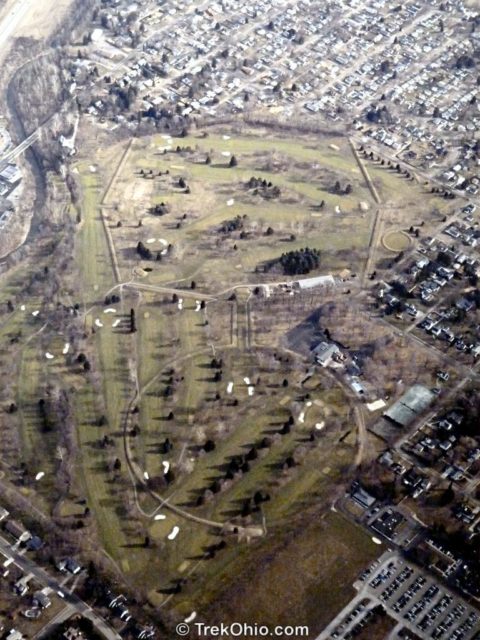
surrounded by a residential community.
The Newark Earthworks were built by a Native American civilization that came into being around 200 B.C. and ended about 500 A.D. This civilization stretched from the Great Lakes region to the Gulf of Mexico. Many of the artifacts found in Ohio were no doubt acquired by trade with distant societies as demonstrated by such finds as shark teeth, conch shells, and obsidian from what’s now Yellowstone Park. Since these people had no vehicles or horses, the distance that such goods traveled is amazing.
By the time settlers of European descent began arriving in the late 1700s, the Native Americans who resided in Ohio had no knowledge of these earlier people, so we don’t know what they called themselves. Warren K. Moorehead was the first archaeologist to examine their mounds on a farm owned by Captain Mordecai Hopewell. Moorehead named this extinct civilization the “Hopewell Culture” after the family who gave him access to the mounds on their farm in Ross County, Ohio.
The Octagon Earthworks
It has been conjectured that the octagon might have served some astronomical purpose related to the moon as described by the diagram in the following sign that I photographed.
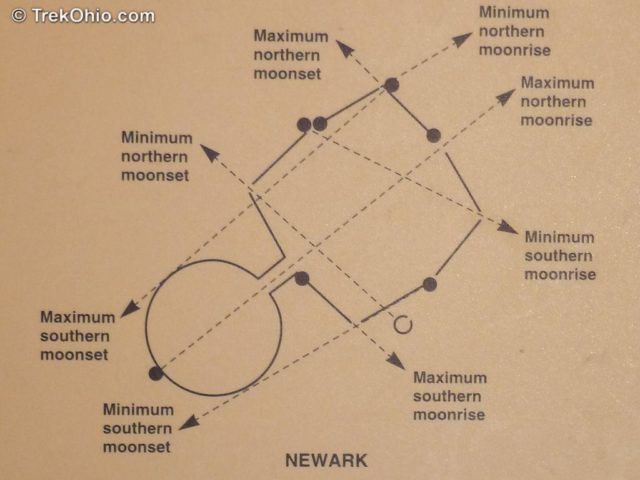
I actually found myself a bit skeptical of the above theory. A lot of the arrows drawn on the above diagram seem rather arbitrary, especially the one showing the “Minimum northern moonset” whose initial point doesn’t coincide with any feature of the octagon. In addition, the above minimums and maximums were calculated to correspond to events in a complicated, 18.6 year lunar cycle which also added to my skepticism. But then I’m neither an archaeologist nor an astronomer, so my skepticism may be ill-founded.
When visiting the Octagon Earthworks in person, I was very surprised to learn that since 1910 the site has been leased by a private country club, and to this day this archaeological treasure remains a golf course. ![]() Newspaper accounts explain that the decision to lease the property for golfing was to get the ground “in shape, cleaned up and opened for the public benefit…” In other words, this private company would fund the restoration and maintenance of the earthen structures.
Newspaper accounts explain that the decision to lease the property for golfing was to get the ground “in shape, cleaned up and opened for the public benefit…” In other words, this private company would fund the restoration and maintenance of the earthen structures.
Since the Octagon Earthworks is a golf club, you can’t just traipse around the place. Instead there is an observation deck that has been built next to the walled passage between the octagon and the circle. You can climb up there to see over the wall of the structure. After that you are allowed to follow a pathway around a portion of the outer periphery of the wall as depicted in the sign below.
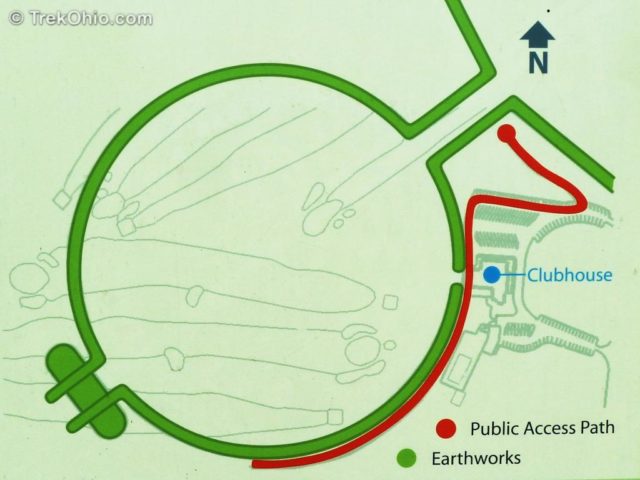
After taking a look over the mound, you can follow the red path around the periphery.
Here’s what the observation deck looks like from the ground.
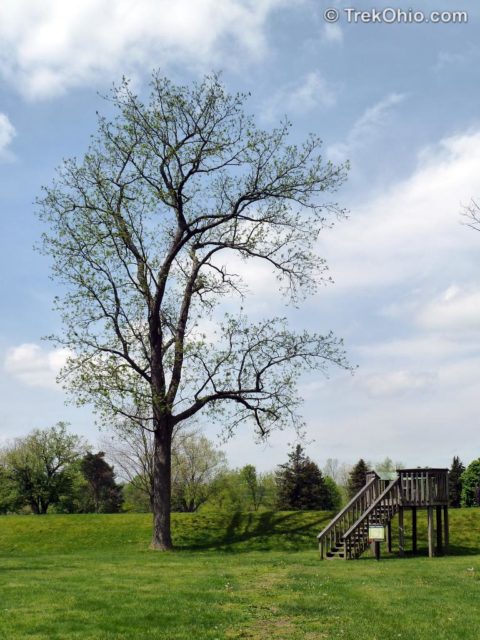
The walled passage is behind the deck.
Here’s a view from the observation deck looking down the passageway toward the opening of the circle.
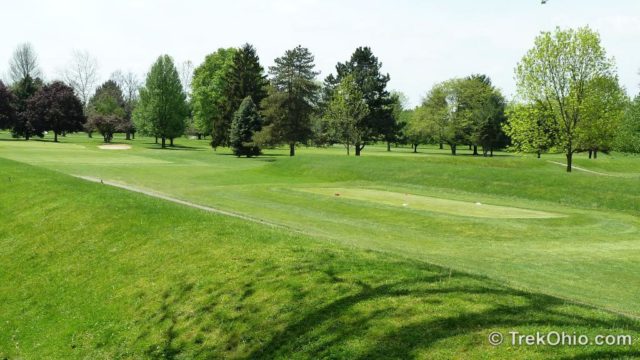
After walking along the periphery you get a glimpse of the “Observatory” — so-called because it is a much higher mound than the surrounding, circular earthworks, and it lies exactly opposite the passageway between the octagon and the circle.
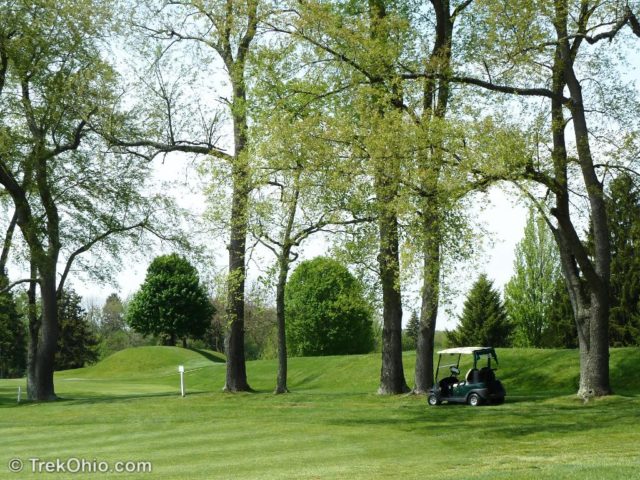
Going somewhat farther than this, you can see the rear portion of the Observatory.
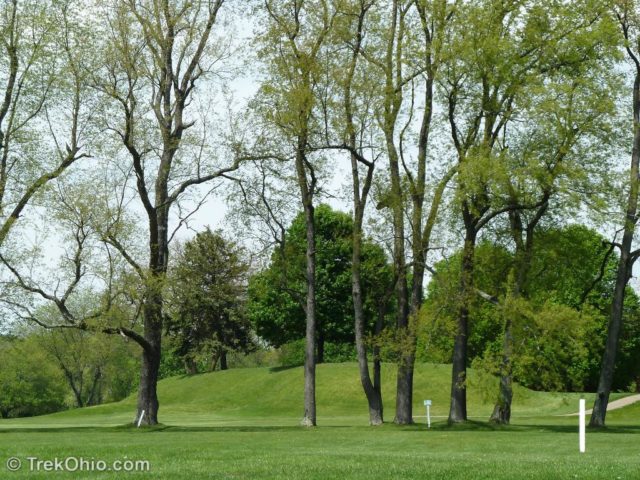
I photographed the interpretive sign below which shows an aerial view of the Observatory with golf cart paths entering the circle on either side of it.
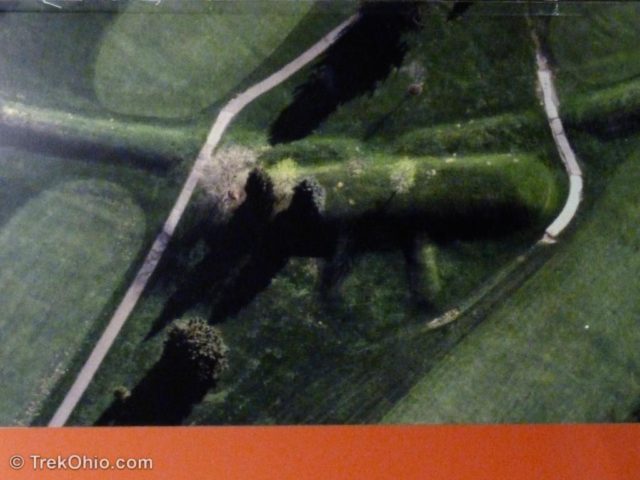
The country club allows visitors to enter the golf course within the mound walls during the following hours. From April through October you can gain entrance to the space within the walls on Monday mornings as long as no special function is being held. From November through March the interior of the circle can be examined during daylight hours all day on Mondays.
The Great Circle Earthworks
Besides checking out the Octagon Earthworks, my friend (Connie) and I also went to see a different segment of the Newark Earthworks, known as the Great Circle Earthworks. In the first photo of this article, the Great Circle Earthworks is the topmost circle illustrated on the metal plaque. Unlike the Octagon Earthworks, the interior of the circle is just lawn and trees with a few small mounds in the center of the circle. Outside one side of the circle is a community park with picnic tables and grills. Outside the entrance to the Great Circle is a museum with restroom facilities.
The walls themselves looked different in that they had something like a moat near the wall. It’s not believed that any of these earthwork structures were used as a fort or for defensive purposes, so rather than actually being a moat, the dirt once in these deep ditches was probably piled on top of the adjacent mound.
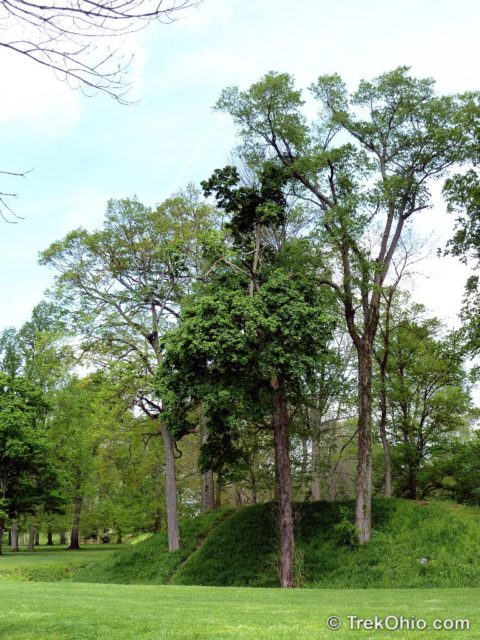
From the inside of the circle you can see one stairway that crosses the moat and goes up over the mound. This stairway was built during the Great Depression by the CCC, and it joins the exterior, community park with the interior of the Great Circle.
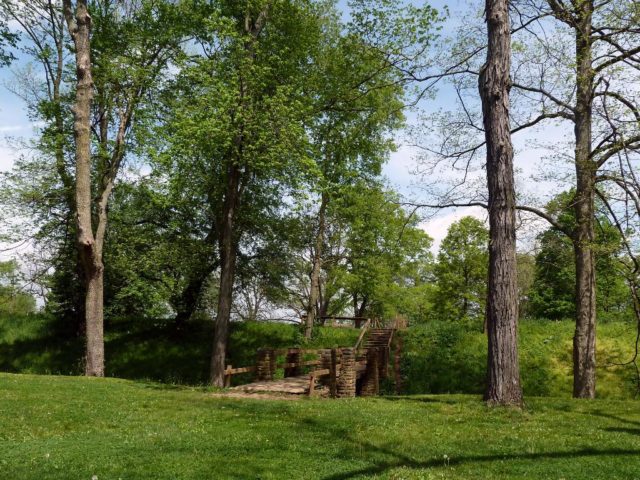
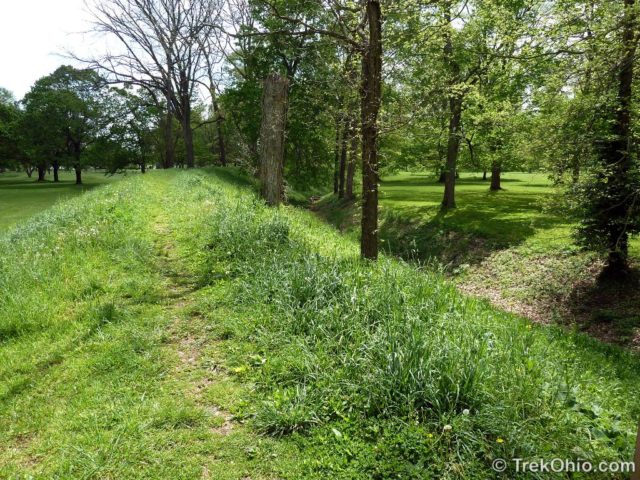
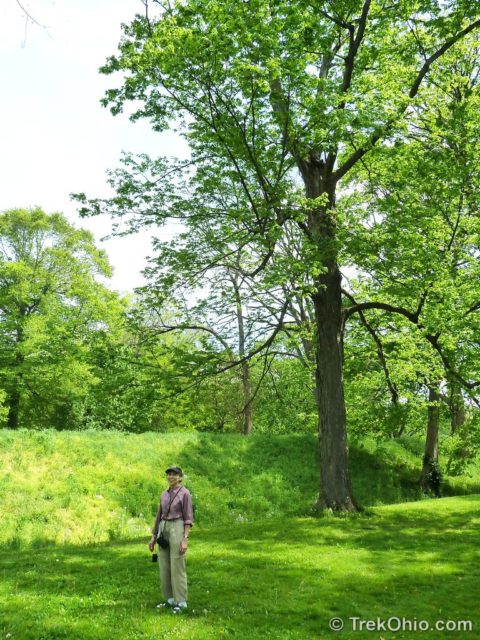
Near the center of the Great Circle are several small mounds. These are believed to be the foundation for some sort of structure in the interior.
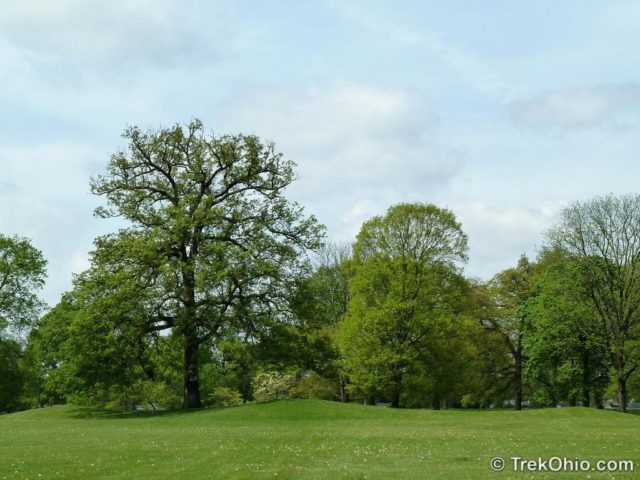
Unlike the Voss Site that I discussed previously, none of the geometric earthworks making up the Newark Earthworks are believed to be burial mounds. Although it looks like they may have been fort-like structures, that’s not the case either. It turns out all post holes for homes occur outside of the earthworks. It is believed that the earthwork structures must have had some social, religious, and/or astronomical purpose, but not much more than that is known. Whenever archaeologists want to study these structures, contemporary Native American groups do all they can to block any study of the area because they feel that such scientific study would dishonor the Native Americans who once lived here. Meanwhile the archaeologists counter that it would bring honor to such people to learn something about their ways since this prehistoric group’s story wasn’t transmitted to those living now.
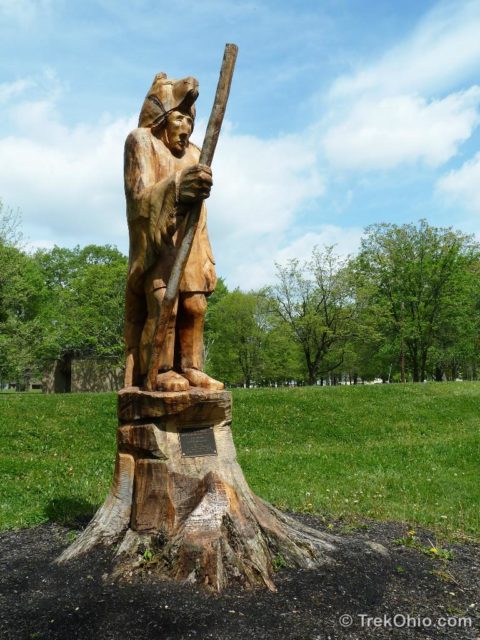
Additional information
- TrekOhio: Licking County Parks & Nature Preserves — This is the county where the earthworks are located; check this page for official links and for information on nearby parks and preserves.
Location
- Octagon State Memorial
- Address: N 33rd St., Newark, Ohio 43055
- GPS coordinates: 40.052092,-82.448359
- View or get directions from Google Maps
- Moundbuilders State Memorial (Site of Great Circle Earthworks)
- Address: 455 Hebron Rd., Heath, Ohio 43056
- GPS coordinates: 40.041185,-82.431001
- View or get directions from Google Maps
More on Native American History in Ohio
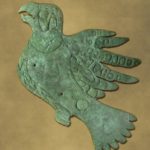
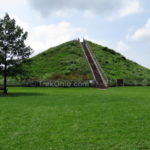
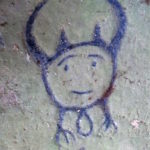
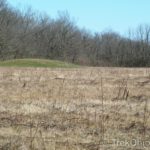
I think that without being on the spot this is difficult to understand. I love very much that statue of Native American. It is awesome. I love wooden carved statues and I have a big collection of them.
Thank You very much this interesting post.
Interesting and amazing, wow!
Thanks, Donna.
Amazing story…thanks! 🙂
Your welcome, Carol. 🙂